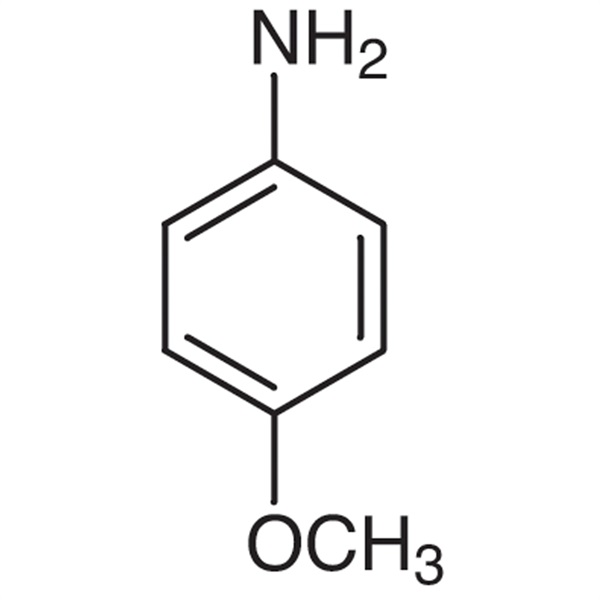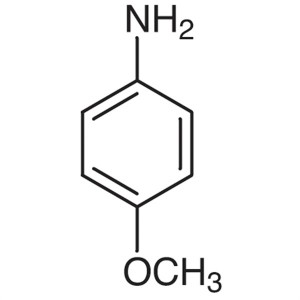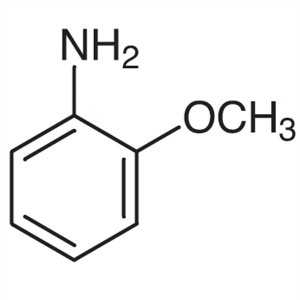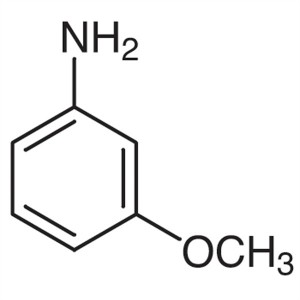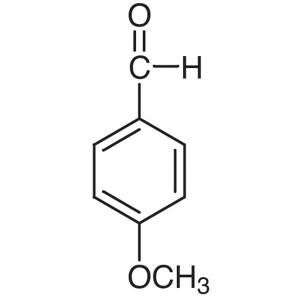p-Anisidine CAS 104-94-9 Purity >99.0% (HPLC) Factory
Shanghai Ruifu Chemical Co., Ltd. is the leading manufacturer of p-Anisidine (4-Methoxyaniline) (CAS: 104-94-9) with high quality, commercial production. Ruifu Chemical can provide worldwide delivery, competitive price, excellent service, small and bulk quantities available. Purchase p-Anisidine, Please contact: alvin@ruifuchem.com
| Chemical Name | p-Anisidine |
| Synonyms | Para Anisidine; 4-Methoxyaniline; 4-Aminoanisole; p-Aminoanisole; 4-Methoxybenzeneamine; |
| CAS Number | 104-94-9 |
| Stock Status | In Stock, Production Scale Up to Tons |
| Molecular Formula | C7H9NO |
| Molecular Weight | 123.16 |
| Melting Point | 56.0~59.0℃(lit.) |
| Boling Point | 240.0~243.0℃(lit.) |
| Flash Point | 122℃ |
| Density | 1.06 |
| Refractive Index | 1.5559 |
| Sensitive | Light Sensitive, Air Sensitive, Heat Sensitive |
| Water Solubility | Slightly Soluble in Water, 21 g/L (20℃) |
| Solubility in Methanol | Very Faint Turbidity |
| Solubility | Very Soluble in Ether, Alcohol. Soluble in Benzene, Acetone |
| COA & MSDS | Available |
| Sample | Available |
| Origin | Shanghai, China |
| Brand | Ruifu Chemical |
| Item | Specifications |
| Appearance | Yellow Brown Powder |
| Purity / Analysis Method | >99.0% (HPLC) |
| Ortho-Ahisidine | <0.50% |
| Para-Chloroaniline | <0.40% |
| Low-Boiling Residues | <0.20% |
| High-Boiling Residues | <0.30% |
| Melting Point | 56.0℃~59.0℃ |
| Moisture (K.F) | <0.50% |
| Total Impurities | <1.00% |
| Test Standard | Enterprise Standard |
| Usage | Pharmaceutical Intermediates |
Package: Bottle, Aluminium foil bag, 25kg/Cardboard Drum, or according to customer's requirement
Storage Condition: Store in sealed containers at cool and dry place; Protect from light and moisture
Instrument
High performance liquid chromatography with automatic sampler and PDA detector.
Electronic analytical balance
Reagents
Methanol (chromatographic grade)
Chromatographic conditions
Chromatographic column SYMMETRY C18 4.6*250mm/5μm or a column with equivalent properties
Detection wavelength: INC220nm
Flow rate: 1.0mL/min
Sample size: 10μL(reference)
Diluent: Methanol
Data collection time: 20.00min
Mobile phase preparation
Acetonitrile: Water = 50:50
Measure
Appropriate amount of sample was taken, dissolved and shaken with mobile phase, and the sample was injected. The detection wavelength was 220nm, and the measured content was not less than 98% according to the area normalization method.
Calculation of Results
The peak area normalization method was used to calculate the HPLC purity.
The relative mean deviation of purity of two needles shall not be greater than 1%
If the results of both injections meet the acceptance criteria, the average purity is taken as the final result.

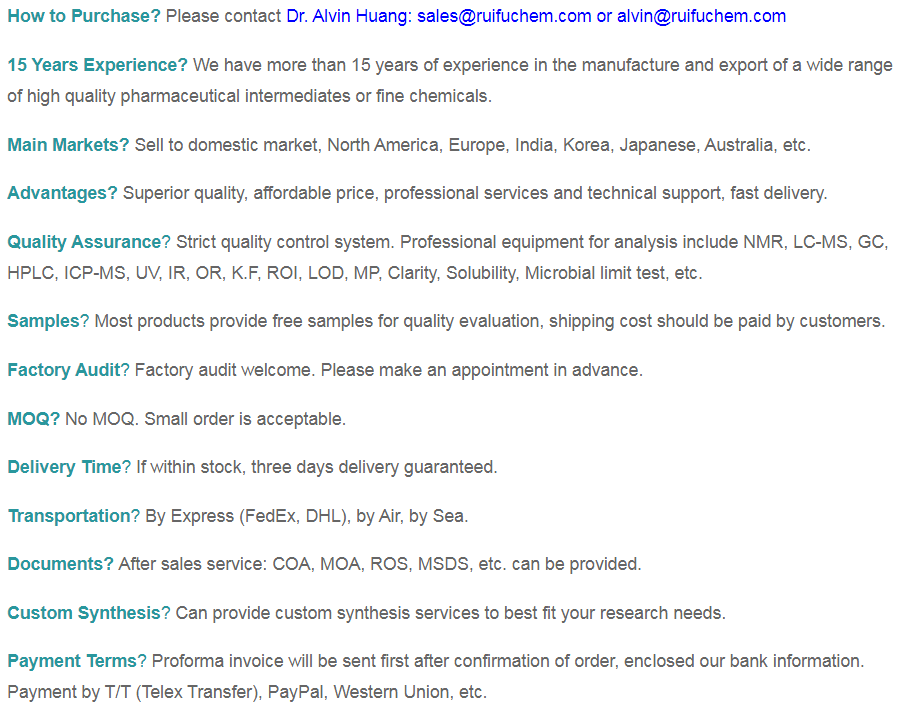
Risk Codes R45 - May cause cancer
R26/27/28 - Very toxic by inhalation, in contact with skin and if swallowed.
R33 - Danger of cumulative effects
R50 - Very Toxic to aquatic organisms
Safety Description S53 - Avoid exposure - obtain special instructions before use.
S28 - After contact with skin, wash immediately with plenty of soap-suds.
S36/37 - Wear suitable protective clothing and gloves.
S45 - In case of accident or if you feel unwell, seek medical advice immediately (show the label whenever possible.)
S61 - Avoid release to the environment. Refer to special instructions / safety data sheets.
S28A -
UN IDs UN 2811 6.1/PG 3
WGK Germany 2
RTECS BZ5450000
FLUKA BRAND F CODES 8
TSCA Yes
HS Code 2922 2910.00
Hazard Class 6.1
Packing Group III
Toxicity Acute oral LD50 for rats 1,400 mg/kg, mice 810 mg/kg, rabbits 2,900 mg/kg (quoted, RTECS, 1985).
p-Anisidine, also known as 4-Methoxyaniline, (CAS: 104-94-9), 1. p-Anisidine is used mostly for producing dyes, and some smaller quantities are employed in making pharmaceuticals and liquid crystals. Mainly used in the dye industry to prepare ice dyes, such as jujube-based GP, blue salt VB, phenolic phenol AS-RL, phenolic phenol AS-SG, C.I. disperse blue 79 and other dyes. 2. Used as pharmaceutical intermediates such as indomethacin, adipine and pirin. 3.Used as a complexing indicator for the determination of high iron, also used in organic synthesis. 4. In the preparation of azo dyes; corrosion inhibitor; chemical intermediate. 5. p-Anisidine is used as a reagent to indicate the secondary stage of the oxidation, it is one of the three possible isomers of the Anisidine or methoxyaniline. The other two isomers are o-Anisidine (2-Methoxyaniline) and m-Anisidine (3-Methoxyaniline). The p-Anisidine is widely used as an intermediate in the production of numerous azo and triphenylmethane dyes, and pigments. It is also used in the production of pharmaceuticals including the guaiacol expectorant, as an antioxidant for polymercaptan resins, and as a corrosion inhibitor for steel. Apart from the beneficial use of p-anisidine, it is toxic for human beings. The acute exposure may cause skin irritation, whereas the chronic exposure may cause headaches, vertigo, and blood complications like sulfhemoglobin, and methemoglobin.
Strong irritant. Toxic when absorbed through the skin. Questionable carcinogen. Inhalation, ingestion, or transdermal absorption of p-aminoanisole is harmful. Has a stimulating effect on the skin. Its vapor or aerosol has a stimulating effect on the eyes, mucous membranes, respiratory tract. Entry into the body results in the formation of methemoglobin and cyanosis. Chronic Effects: can cause respiratory system, skin allergic reactions.
p-Anisidine may be sensitive to heat, light and moisture. Reacts with acids, acid chlorides, acid anhydrides, chloroformates and strong oxidizing agents. Incompatible with alkaline materials. Incompatible with aldehydes, ketones and nitrates.
p-Anisidine is flammable.
Moderately toxic by several routes. A mild sensitizer. May cause a contact dermatitis. Mutation data reported. Questionable carcinogen. See also ANILINE. When heated to decomposition it emits toxic fumes of Nox.
UN2431 Anisidines, Hazard Class: 6.1; Labels: 6.1-Poisonous materials.

